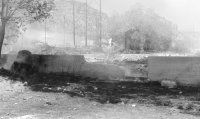| This recent blaze in Martin shows how wildfire that starts in many different ways can burn up to a structure and start it on fire. Luckily, this foundation did not have a house on it, but if a house had existed there the dry grass and weeds around the foundation could have ignited siding or other items on the structure or near to it. |
Several towns in the West have been evacuated because of range and forest fires. This has raised increased concern over how landscaping choices affect homes’ vulnerability to wildfire damage.
“The danger is the most severe along the ‘wildland/urban interface,'” says Mike Kuhns, Utah State University Extension forester. “These are the previously undeveloped areas, on the edges of cities. The trees, shrubs and grasses in these area are often highly flammable. Vacation homes and cabins are also at risk because they go unattended for days or weeks at a time.”
Firewise landscaping deals with a combination of issues, Kuhns says � thinning, pruning and occasionally clearing native vegetation. This doesn’t mean you have to clear your landscape of all vegetation, but you should consider using plants that reduce the risk of fire spreading to your home.
“Fire needs fuel to move from place to place and there are certain types of plants that are more likely to act as a bridge from the native vegetation to your home or cabin,” he says. Your landscape design should reduce the fuel load between your home and the surrounding wildland.
Kuhns explains that firewise plants are those that have one or more of these characteristics:
•Tissues contain more moisture, especially during the fire season.
•Tissues contain low amounts of volatile oils and other readily flammable chemicals.
•Plants provide less fuel either by producing less litter or by staying small.
•Plants are compact or low to the ground, allowing them to be used in landscaping to interrupt fire pathways.
Trees provide large amounts of fuel for fire, so they should be most carefully selected, placed and maintained, he says. Broadleaf trees generally are less flammable than conifers.
Also, choose plants that are low to the ground, compact and stay green and healthy with low maintenance and minimal water, Kuhns says.
Even firewise plants need periodic maintenance including removal of dead leaf and stem material, pruning to keep crowns thinner and removal of individual plants to break up a chain of fuel that may lead fire to the house, he says. This is especially true of dry, fallen material that may accumulate around the foundation or in rain gutters. Intense wildfires can send out tongues of fire that reach far beyond the fire front to ignite this debris.
For a list of firewise plants go to: http//extension.usu.edu/publica/natrpubs/ff002.pdf

